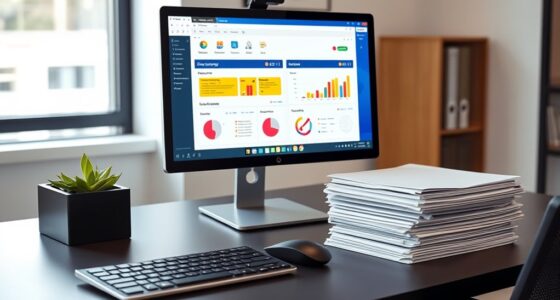Collaborating on documents remotely becomes smooth when you use tools that support real-time editing and version control. You can work simultaneously with your team, see changes instantly, and avoid confusion from multiple file versions. These features guarantee everyone stays aligned, even across different locations and time zones. Plus, you can easily track who made what change and revert if needed. Keep going to discover even more strategies to improve your virtual teamwork.
Key Takeaways
- Utilize real-time editing tools to enable simultaneous updates and instant visibility for remote team members.
- Implement version control systems to track changes, revert mistakes, and maintain document history.
- Use collaboration platforms that integrate real-time editing and versioning for seamless teamwork.
- Establish clear protocols for editing and commenting to prevent conflicts and improve communication.
- Leverage additional tools like activity tracking and predictive modeling to optimize remote collaboration workflows.

In today’s increasingly remote work environment, collaborating on documents has become more essential than ever. Whether you’re working with colleagues across different time zones or sharing files with clients worldwide, seamless collaboration hinges on effective tools and strategies. One of the key features that enable smooth teamwork is real-time editing. When you and your team can edit a document simultaneously, it eliminates the back-and-forth of sending files back and forth. Instead, everyone sees changes as they happen, making it easier to brainstorm, refine ideas, and make quick adjustments. This immediacy keeps projects moving forward without delays, fostering a more dynamic and responsive workflow.
However, real-time editing alone isn’t enough to prevent confusion and chaos, especially when multiple people modify the same document. That’s where version control comes into play. Version control keeps a record of all changes made to a document, allowing you to track who did what and when. If a mistake is introduced or an unwanted change slips through, you can easily revert to a previous version. This feature provides peace of mind, knowing that your team can experiment freely without risking the loss of important information or the integrity of the document. It also encourages collaboration, as team members feel more confident making edits, knowing they can always undo mistakes or compare different versions to see how a document has evolved.
When you’re working remotely, these tools become even more vital. Without face-to-face interaction, miscommunications can easily occur, but real-time editing combined with robust version control helps mitigate these issues. They create a shared environment where everyone can contribute confidently, knowing that the document’s history is preserved and accessible. Additionally, many collaboration platforms integrate these features seamlessly, so you don’t have to juggle multiple tools or worry about compatibility issues. They also often include notifications or activity logs, so you’re always aware of recent changes and who made them, further enhancing transparency and accountability.
In practice, leveraging real-time editing and version control means you can focus more on content quality rather than managing file versions or resolving conflicts. It simplifies coordination and keeps everyone on the same page, regardless of their physical location. As remote teams grow, adopting these features isn’t just a convenience; it’s a necessity for maintaining efficient, productive collaboration. By mastering these tools, you guarantee your team stays connected, your work remains organized, and your projects move forward smoothly—no matter where you’re working from. Additionally, predictive modeling can help anticipate potential issues in collaborative workflows, enabling proactive management of project timelines and resources.
Frequently Asked Questions
How Secure Is Cloud-Based Document Collaboration?
Cloud-based document collaboration can be quite secure if the platform uses strong encryption protocols to protect your data in transit and at rest. Access controls also play a crucial role, ensuring only authorized users can view or edit documents. While no system is completely foolproof, choosing providers with robust security measures helps safeguard your information. Always review their security policies to ensure your data remains protected.
Can Multiple Users Edit a Document Simultaneously Without Conflicts?
Yes, multiple users can edit a document simultaneously without conflicts if the platform uses effective version control and editing permissions. You can see real-time updates and track changes, which minimizes overlaps. The system manages conflicts automatically or prompts you to resolve them, ensuring smooth collaboration. Just make sure your editing permissions are correctly set so everyone has appropriate access, and the version control system keeps your work organized and secure.
What Are the Best Tools for Real-Time Remote Collaboration?
When choosing tools for real-time remote collaboration, you want options that support offline editing and robust version control. Tools like Google Docs and Microsoft 365 allow multiple users to work simultaneously, ensuring edits are synchronized smoothly. They also let you access documents offline and track changes over time. These features help prevent conflicts and keep everyone on the same page, making collaboration seamless whether you’re online or offline.
How Do I Track Changes Made by Different Collaborators?
To track changes made by different collaborators, you should use tools that offer version history and change notifications. These features allow you to see who made specific edits and when. Enable change notifications to stay updated on modifications in real-time. Regularly review the version history to compare different versions of the document, ensuring you can easily track contributions and revert to previous states if needed.
What Should I Do if a Collaborator’s Edits Conflict?
Did you know that 65% of remote teams face version conflicts regularly? When a collaborator’s edits conflict, first check their editing permissions and make certain only one person edits a section at a time. Use document version history to compare changes and resolve conflicts. Communicate clearly with your team to decide which edits to keep, minimizing confusion and maintaining a smooth workflow.
Conclusion
Now that you know how to collaborate on documents remotely, you’re equipped to navigate teamwork like a skilled sailor steering through any storm. Remember, clear communication and shared tools are your compass and map, guiding you to success even when miles apart. Embrace the flexibility and trust in your collaboration skills—because, just like a well-coordinated crew, your combined efforts can turn any challenge into smooth sailing. Keep working together and watch your projects flourish.









